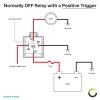Yes, that makes perfect sense. So, basically, I would need to install a relay that would be triggered by the 15-AMP switched circuit and send power directly from the battery to the Cellink Neo, correct? So basically, it would look something like this except the switch would be the 12V ACC circuit and the lights would be the Neo. I actually only need a 4 prong fuse, but I can't find that as a complete kit on Amazon.
First off, if you intend to use a relay, you should buy one with a matching socket. The relay will plug into the socket, and the socket will have a short lengths of wires attached in order to make your wire connections. If you intend to install this relay within the engine compartment, then you should be sure to buy a waterproof relay and socket. That diagram you included only complicates things. Most standard relay pins are referred to by numbers, usually 85 and 86 for the activating circuit, and the activated circuit 30, 87 and 87a -- 30 to 87a is normally closed (connected) and 30 to 87 is normally open (unconnected). Then you pass an activating current though pins 85 and 86, the relay connects pins 30 to 87 and disconnects pins 30 to 87a. In this manner, one circuit with low current requirements can switch another circuit though which a much greater current can flow. (This describes a SPDT relay -- Single Pole, Double Throw)
For the Cellink Neo connections, you won't need to connect 87a to anything. Tape it off safely and securely.
The rest of the pins would be connected like this:
85 to ground (opposite to din standard to accommodate a relay with built-in diode if used)
86 to 12V ignition source (opposite to din standard to accommodate a relay with built-in diode if used)
30 for 12V constant (at battery post perhaps)
87 to Cellink Neo 12V ignition switched input.
In a mechanical relay, a flowing current between pins 85 and 86 energize a wire coil which switches the higher current circuit via electromagnetism -- it literally changes the position of an internal switch topped an iron tip. (That's the click you'll hear.) These days there are decent relays and unfortunately many not so decent cheaply made relays, which are not well designed to last as long as others used to. You can probably discern between the good and the bad by reading the associated reviews. (If you would like to verify your choice for any red flags, feel free to ask via pm.)
One last very important note, and
perhaps even the most important of all depending upon which ignition switched fuse you choose to trigger the relay. In modern cars, computerized electronics turn on and off many if not most or all of the circuits, and they can be very sensitive to certain types of electrical issues, and especially so in the case of a reverse high voltage current caused by the collapsing electromagnetic field of a de-energized relay coil. So you must protect the car's activating 12v ignition switched circuit by installing a diode or a resistor into the relay circuit -- or better yet, choose a relay with one already installed within its case. It would also be best if you could find a circuit that is already isolated from the car's electronics by a factory installed relay. The factory relay will protect the car's electronics, and you can safely use the switched side of that relay to trigger your new additional relay. (Though I would still suggest a relay with a built-in resistor or diode anyway. They're easily found and they're usually of better quality too.)

